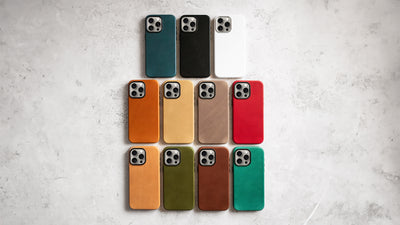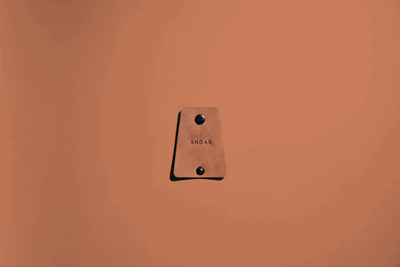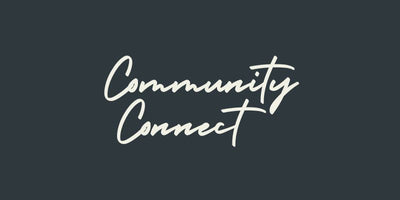The Blog
What Is Leather Made of, and Where Does It Come From?

\Many people own at least one, if not a few, leather goods. The material makes for a popular ingredient in leather bags, purses, and wallets. Home goods include upholstery, and apparel includes leather jackets.
High-quality leather is particularly sought after, not only for its appearance but also for its longevity. There’s a reason the market generates over 75 billion USD in revenue annually, with that number continuing to climb.
But what actually is leather? Many of us have a vague idea — that it is a derivative of plants, animals, or synthetic fibers. However, the actual process of creating leather is significantly more complex.
Andar believes in goods that last. In this article, we will be explaining the process behind the best leather products. After that, we will further showcase why this process gives them the desirable qualities people cherish.
When Was Leather First Used (and Leather Making History)
When it comes to practical material for clothing and daily living, leather is among the oldest we have records of.
Ancient Egypt
The earliest confirmed incidences of leather making, as we recognize, date back 7,000 years ago, in ancient Egypt. Some evidence suggests practices may even predate this, but this marks the oldest confirmed application of leather making.
The process began by taking a base material, then drying it in the sun. From there, the base fabric is treated with salting and smoking. This practice is also used in the food industry to increase the shelf life of products.
The Fourth Century BCE
Several thousand years after this, in around the 4th century BCE, a new process for tanning leather began. This included vegetables to give the leather a richer color and to improve its endurance.
The Middle Ages
By the end of the Middle Ages, leather-making spread across Europe, with Spanish and Italian leather products being highly prized. Products commonly seen included saddles, shoes, bags, trunks, and cases. To this day, Florence, Italy, is an international hub for leather making.
The Industrial Revolution
The 19th century saw the introduction of machines to leather-making practices. This helped improve the speed and consistency with which leather goods could be produced. With the Industrial Revolution, the world also saw an upheaval in production as chemical processes were introduced.
Modern Day
From there, the 20th century saw a massive change in how leather was produced. The first synthetic leathers appeared during this time, though their quality paled in comparison to the best natural leathers. The first real competitor to natural leather has only appeared in the last few decades in the form of cactus leather.
With this, we have, in microcosm, a look at thousands of years of leather-making history. Now, it’s time to look at what a piece of leather looks like, from start to finish, in 2023.
How Is Leather Processed?
Unprocessed leather begins to drop in quality immediately upon its harvesting. The first real step in processing leather is to preserve it for transportation and the remainder of the process. This could be air-drying or salt-drying to help dehydrate the fabric.
Pickling
Though it may sound unusual, sometimes leather is exposed to pickling to help prepare it for the next step. Pickling with the right enzymes can even enhance later steps in the process, like dyeing.
Once the leather has been transported to a tannery, the leather tanning can begin. The tanning process involves removing all extraneous fiber and any water-soluble materials from the fabric.
Liming
The removal process is known as liming because it is done in a solution of lime and water. This loosens extraneous fibers, which can be removed by hand or machine. The next step, then, is actual tanning. Traditionally, leather is exposed to tannins, a mild acid that displaces water in the fabric and creates a firm material.
Tanning
Vegetable-tanned leather is the oldest currently practiced method. Leather products are soaked in tannin liquors extracted from tannin-rich parts of plants like tree bark. Tanning takes weeks, possibly even months. It results in a firm, richly-colored and water-resistant product.
Alternate tanning methods include mineral treatment with chromium salt or fish-derived oils. As a tanning agent, chromium salt speeds up the leather manufacturing process. In addition to being faster, the process results in lighter-colored, more pliable materials. This makes it great for lightly-colored handbags and other personal goods.
Drying and Dying
After tanning, the leather is dried and further dyed to reach its desired end state. It may be stretched and treated to give it water resistance along with other protective measures. With this final step, the leather is ready to enter everyday products.
The Main Types of Leather
Naturally, with so many variations in the leather-making process and in material, there are many different types of leather. These feature various appearances, quality, and even longevity, so knowing their differences is essential.
What Is Split Leather?
One of the lowest quality leather materials is split leather because the material's natural “grain” is missing. The grain of leather refers to the consistency and composition within a given piece of fabric. In split-grain leather, separate parts are bonded together through chemical or mechanical processing.
Similar to split leather is bonded leather which is leather scraps attached together with polyurethane. This is also considered a lower-quality material.
What Is Genuine Leather?
A similarly low-quality offering is genuine leather. “Genuine” sounds good, but all it means is that the product is made from real leather. The product can be altered and processed as much as possible while technically being genuine.
What Is Top-Grain Leather?
Top-grain leather is a higher level of quality. It is made from the upper layer of fabric and generally has better durability and water resistance. It’s still not quite as high-end as the best type of leather.
What Is Full-Grain Leather?
Only full-grain leather leaves the natural grain of the material totally intact. This results in a material that lasts longer than other leather types and feels and looks better. Even though all leather is processed, the base material is largely unadulterated. Full-grain leather also develops a natural sheen over time called a patina.
Other Leather Types
Leather comes in numerous types. The above are considered among the “main” types of leather, but other variations exist.
Faux leather generally refers to a variety of synthetic leather alternatives which emerged in the 1900s. It has a tendency to split and crack and matches quality with regular leather products in appearance alone. Vegan leather, however, creates leather from a variety of plant fibers. The right vegan leather can match full-grain leather in quality.
Suede and nubuck are slightly different on the spectrum. The first of these is made from the underside of the fabric. It’s not as durable as other types, but it has a soft appearance and touch that gives it enduring popularity.
Nubuck, on the other hand, is made from sanding top-grain leather. The material isn’t quite as soft as suede but is significantly more durable and abrasion resistant. These qualities make choosing between the two largely a matter of preference.
Why Choose Leather Products
Leather products have supported civilization for thousands of years for a variety of reasons. Good leather is a quality, long-lasting material that does what, by and large, many other materials cannot. In appearance, feel, and unique qualities — there’s nothing like it in the world!
It’s for these reasons that leather is a standard in everything from clothing to luggage to watch straps and more. From the oldest days of our history to the present day, our use of leather is constantly evolving.
For Andar, leather isn’t just a way of life. It’s a way to improve your life with quality pieces that last forever.
Sources:
Luxury Leather Goods - Worldwide | Statista Market Forecast
Leather | History & Facts | Britannica
Enzymes for Leather Processing: Effect on Pickling and Chroming I National Library of Medicine












